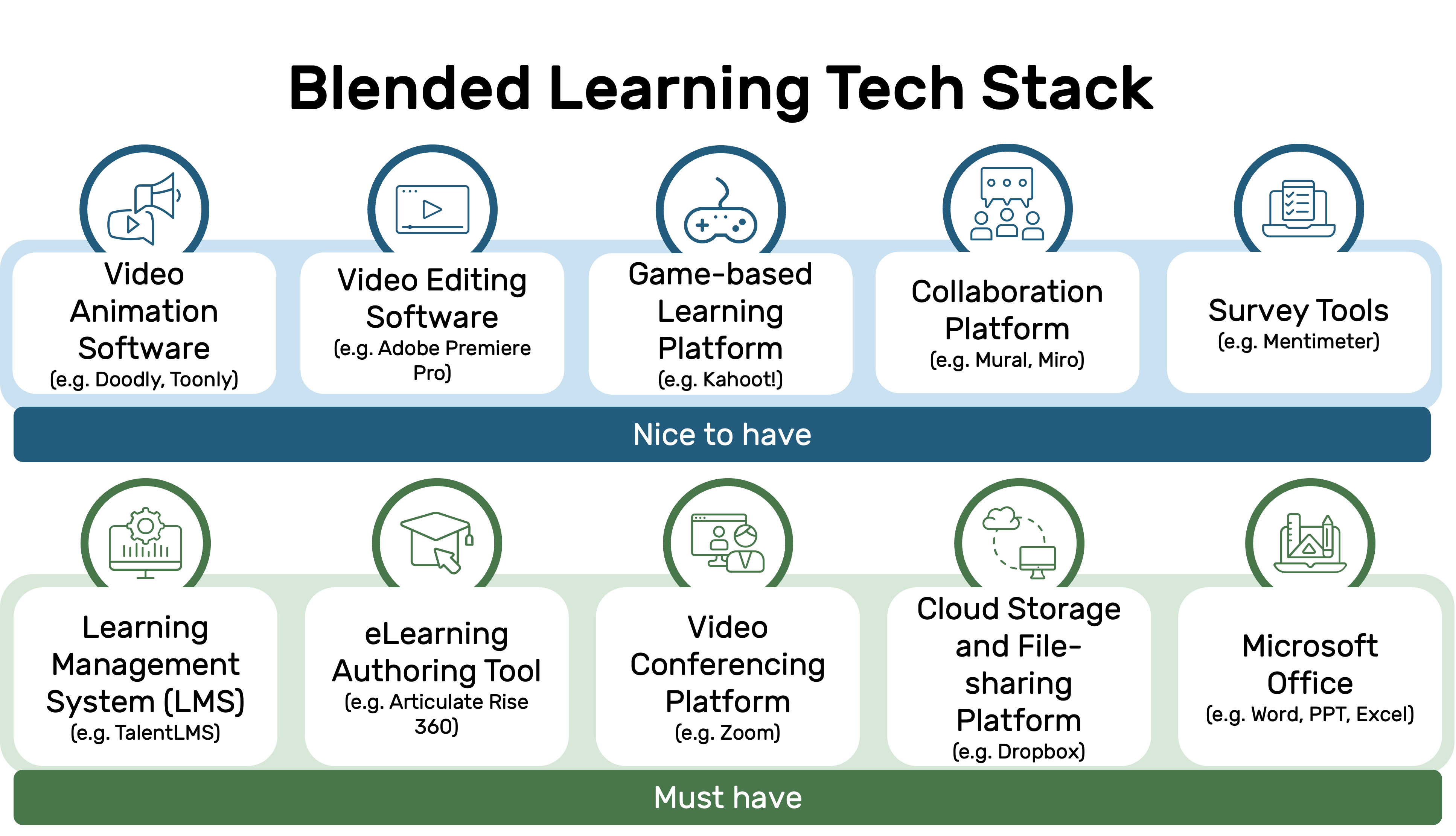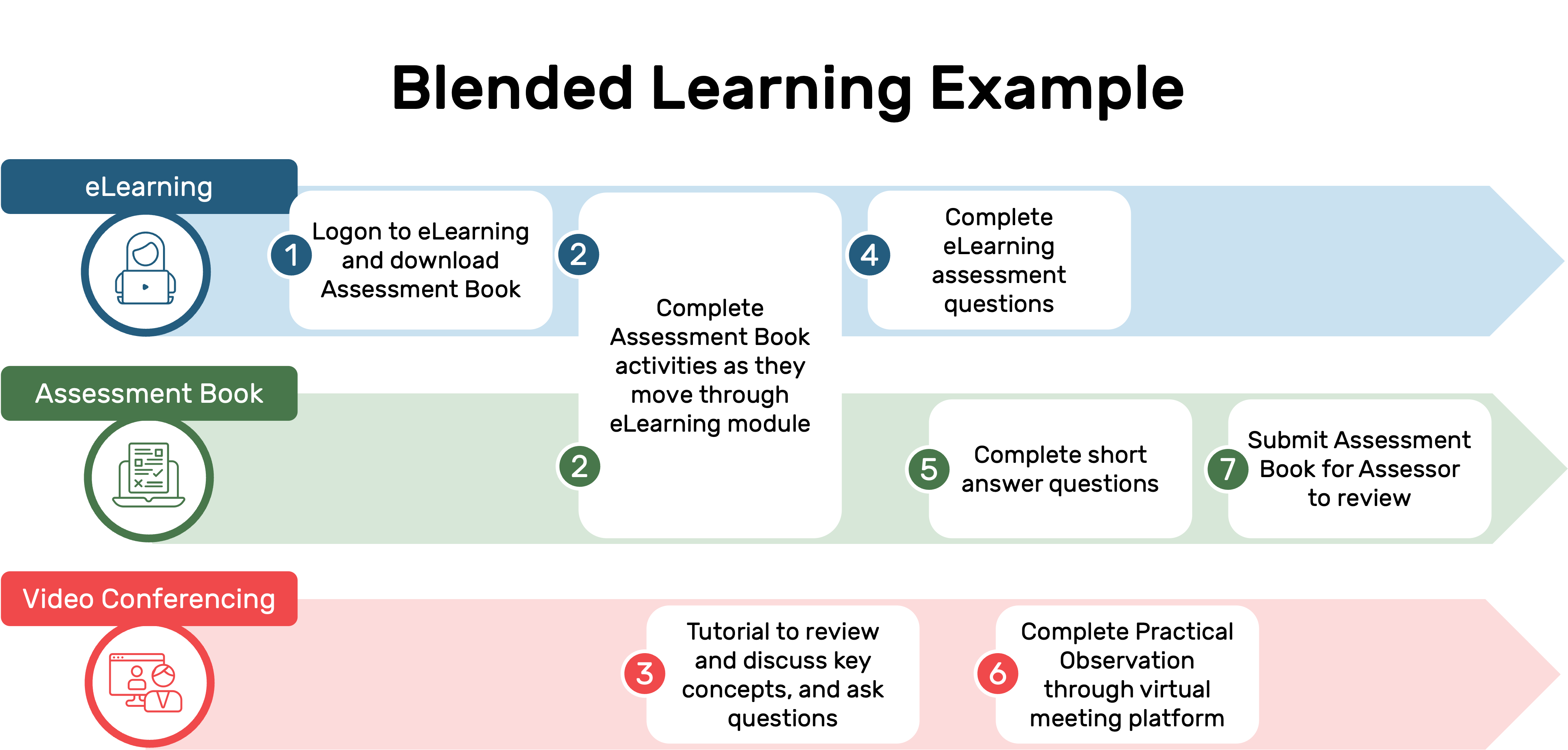Blended Learning
What is blended learning/virtual learning?
Blended learning or virtual learning is not your traditional classroom-like training. Instead, they use a blend of methods to deliver programs.
Blended learning may use online Learning Management Systems (LMS)(e.g. Blackboard, Moodle, TalentLMS or Instructure) to deliver content, submit assessments, and provide instructions for learning experiences and activities to be completed offline.
What is the difference between virtual learning and eLearning?
Whilst both virtual learning and eLearning and delivered online, they are also quite different.
Virtual learning incorporates a blend of delivery methods and learning experiences that are completed online and offline, and may include on-the-job training, self-reflection activities, projects, coaching sessions, instruction to complete practical activities, and other learning experiences. So, whilst some of the content delivery is virtual, a large portion of learning occurs offline. Generally, participants are assigned to groups. A facilitator oversees participants’ work, holds group sessions through online platforms such as Zoom, responds to questions and comments on discussion boards and reviews assessments.
eLearning, on the other hand, is completed predominantly – if not solely – online. It doesn’t require participants to complete learning experiences offline and doesn’t include discussion boards, collaborative activities or interaction with other participants. Assessment forms part of the eLearning (usually multiple choice, mix and match or fill in the gap questions) – a facilitator does not provide individual feedback for each assessment.
The benefits of blended learning
A blend of solutions such as digital, on the job, self-paced and SME coaching has many benefits to both learners and an organisation. It is a great way to provide ‘bite-sized’, ‘just in time’ learning that is flexible in both time and place.
Face-to-face delivery may be limited by time, location and operational constraints, therefore delivering some content and learning experiences through online, on the job or self-paced methods can avoid logistical challenges and save money.
It is great for people who work remotely as they already have the tools required for digital learning.
If the solution is time-critical, you should work with stakeholders to identify the ‘must’, ‘should’ and ‘nice to haves’ to prioritise and focus key learning content. You may also suggest a ‘rolling’ development and release of learning in a phased approach so that both learners and immediate organisational needs are supported.
Blended learning tech stack
There are some technologies that you need to have for blended learning, and some that are ’nice to have’.
How to design blended learning solutions
Read the articles below to learn how to design blended learning solutions:
- The Many (Many, Many!) Instructional Design Models
- Embedding Activities in Learning Design: Why Leaders Matter
- How-To: Design For Online Courses
- Learning Methodologies and Activities
- Do You Want to Create an Online Course or eLearning?
- The 70:20:10 Learning Model
- The AEE Learning Model
Our blended learning solutions
The diagram below provides an example of a blended learning solution we designed and developed for a Certificate II in Skills for Work and Vocational Pathways.
For each module:
- Learners begin by logging on to eLearning and downloading the Assessment Book.
- They then complete assessment activities as they move through the eLearning module.
- Tutorials are held to review and discuss key concepts, and ask questions.
- Learners complete eLearning assessment questions (in eLearning).
- They then complete short answer questions in their Assessment Book.
- Learners complete a Practical Observation through a virtual meeting platform (e.g. Zoom) as the Assessor observes.
- Lastly, they submit their Assessment Book for the Assessor to review.
Note: Learners can arrange a meeting with their Trainer at any point during the course if required.
FAQs
What is a blended learning approach?
Blended learning uses a combination of face-to-face and online learning methods to create effective and efficient solutions.
What is an example of blended learning?
A blended learning solution may require participants to complete an eLearning module to develop an understanding of key concepts before building on their knowledge and applying skills during a face-to-face workshop. Participants may then transfer their learning in the workplace through on-the-job training and embedding activities.
What are the four types of blended learning?
The four model of blended learning are: Rotation, Flex, À La Carte, and Enriched Virtual.
What is the purpose of blended learning?
The purpose of blended learning is to integrate both face-to-face and online learning models to maximise learning. Other advantages include cost benefits, flexibility in both time and place, avoid logistical challenges, and more.
What is the difference between online and blended learning?
Online learning is completed entirely online, and does not require learners to attend face-to-face workshops. Blended learning is the combination of online learning with face-to-face workshops or experiences.
How is blended learning different from traditional classroom teaching?
Blended learning is not your traditional classroom-like training. Instead, it uses a blend of face-to-face and online learning methods to deliver programs.





